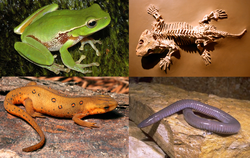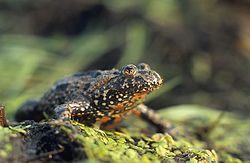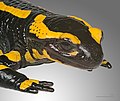User:The Transhumanist/Sandbox144
Introduction
Selected amphibian type
In popular culture (folk taxonomy), toads are distinguished from frogs by their drier, rougher skin and association with more terrestrial habitats. However, this distinction does not align precisely with scientific taxonomy. (Full article...)
Selected frog article

The tailed frogs are two species of frogs in the genus Ascaphus, the only taxon in the family Ascaphidae /æˈskæfɪdiː/. The "tail" in the name is actually an extension of the male cloaca. The tail is one of two distinctive anatomical features adapting the species to life in fast-flowing streams. These are the only North American frog species that reproduce by internal fertilization. They are among the most primitive known families of frogs.
Its scientific name means 'without a spade', from the privative prefix
Selected salamander article
The Caudata are a group of amphibians containing the extant salamanders (the order Urodela) and all extinct species of amphibians more closely related to salamanders than to frogs. They are typically characterized by a superficially lizard-like appearance, with slender bodies, blunt snouts, short limbs projecting at right angles to the body, and the presence of a tail in both larvae and adults.
Disagreement exists between different authorities as to the definition of the terms "Caudata" and "Urodela". Some maintain that Urodela should be restricted to the
The page "User:The Transhumanist/Sandbox144/box-header" does not exist. The page "User:The Transhumanist/Sandbox144/DYK/24" does not exist.
Picture slideshow
-
Male Smooth Newt (Lissotriton vulgarisaka Triturus vulgaris) during breeding season in the Netherlands.
-
Surprise, its an amphibian. This is a genus of South American Caecilians, blind and snake-like, which hunt through leaf litter. Photo from Wildsumaco Reserve, Ecuador.
-
Southern Brown tree frog
-
Edible Frog
-
Limosa harlequin frog
-
Litoria chloris
-
Common toads during amplexus
Selected toad article

The
Selected caecilian article
Caeciliidae is the family of common caecilians. They are found in Central and South America. Like other caecilians, they superficially resemble worms or snakes.
Although they are the most diverse of the caecilian families, the caeciliids do have a number of features in common that distinguish them from other caecilians. In particular, their skulls have relatively few bones, with those that are present being fused to form a solid ram to aid in burrowing through the soil. The mouth is recessed beneath the snout, and there is no tail.
Many caeciliids lay their eggs in moist soil. The eggs then hatch into aquatic larvae, which live in seepages in the soil, or in small streams. However, some species lack a larval stage, with the eggs hatching into juveniles with the same form as the adults, or else lack eggs and give birth to live young. (Full article...)
Categories
Topics
Related portals

Salamanders- Frogs and toads

Paleontology
Extinct and Endangered Species
Paleozoic
Mesozoic
Cenozoic
Reptiles
Birds
Associated Wikimedia
The following Wikimedia Foundation sister projects provide more on this subject:
-
Commons
Free media repository -
Wikibooks
Free textbooks and manuals -
Wikidata
Free knowledge base -
Wikinews
Free-content news -
Wikiquote
Collection of quotations -
Wikisource
Free-content library -
Wikiversity
Free learning tools -
Wiktionary
Dictionary and thesaurus























































